Changes during the Fair
Although many of the exhibits at the Fair were the results of years of planning and design, there were many changes made during the two-year run. Some changes were relatively minor, such as new paint schemes or signage, while in other cases, entire pavilions were changed. This page, which is a work in progress, lists some of these changes. More will be added as they become available, so please stop back again for the latest update.
| Africa Pavilion | 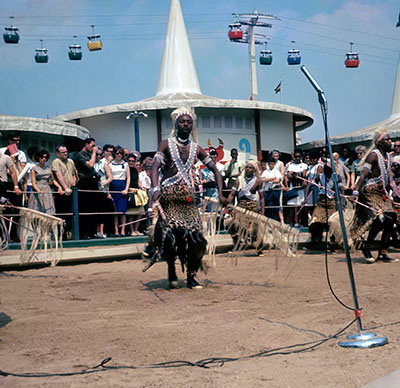
In early 1964 the dancers had to perform in the harsh New York sun. 
A roof was soon added over the performance area. |
| American-Israel Pavilion | 
Views of the pavilion from 1964 show plain wooden exterior walls. 
In 1965 large copies of postage stamps from Israel were added. |
| AMF Monorail | 
The famous Aston Martin DB5 featured in the movie "Goldfinger" was added as a display at the monorail station for 1965. |
| Amphicar Rides | 
These unusual amphibious vehicles were added for the Fair's second season. |
| Amphitheater | 
When the Fair first opened the Amphitheater on Meadow Lake was home to "Leonidiff's Wonder World", an ambitious stage show. 
The show was a costly flop and soon closed. At that point the Amphitheater was briefly occupied by the "Summer Time Revue" starring Clay Cole. 
That show also closed early and for the rest of 1964 the season the Amphitheater was unused. The 1965 season proved to be a better one for this veteran of the 1939-1940 New York World's Fair, for it was taken over by the State of Florida and featured the very popular "Florida Citrus Water Ski Show." |
| Avis Pan American Highway Rides | 
The Pan American Highway Gardens were a tranquil but generally ignored spot in 1964. 
The area was much busier - and far more noisy - with the arrival of a Avis go-cart track in 1965. |
| Bargreen Buffet | 
Originally planned as the Argentina Pavilion, the building was turned into the Pavilion of Fine Art after the original developers ran out of money and were unable to complete construction. This is a 1964 view. 
In 1965 the building became the Bargreen Buffet, a restaurant complex. |
| Belgian Village | 
The Belgian Village ran into financing and construction difficulties during construction, so much of the complex was unfinished when the rest of the Fair opened. The complex was finally opened on August 1, 1964. |
| Bounty | 
The replica of the infamous HMS Bounty was only at the Fair for the 1964 season, as few visitors made it from the main Fair site over to the Marina. |
| Bourbon Street | 
When the Fair first opened the area was known as "Louisiana's Bourbon Street". 
A fallout between some of the financial backers led to the removal of the "Louisiana's" portion of the sign in early 1964. 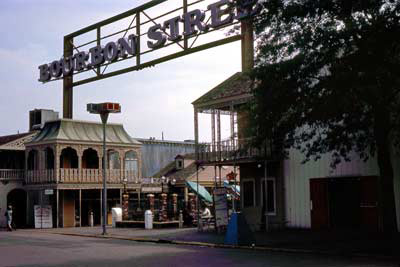
The area received a new entrance design late in the 1964 season that replaced the bland walls and giant figures with facades designed to look like New Orleans architecture. The words "Bourbon Street" in a variety of fonts, sizes, and colors were added to the exterior wall facing the Minnesota Pavilion. In addition, the white signage area over the entrance which had been intended to showcase performers at at failed dinner show venue was removed. |
| Carnival | 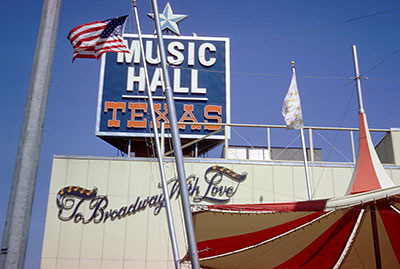
The Texas Pavilions featured the Music Hall and its show "To Broadway With Love." While critically acclaimed, the show was a box office failure and closed during the 1964 season. 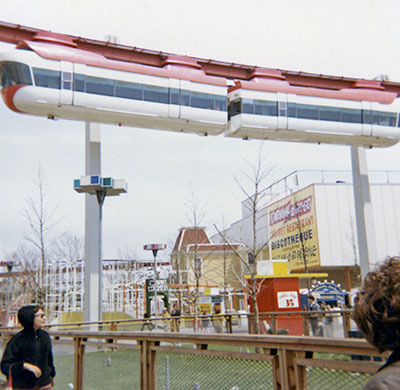
In 1965 there was a new attraction, Carnival, which featured a disco and small amusement rides. |
| Carousel Park | 
Carousel Park was a late addition to the Fair, opening in July 1964. 
It received new lighting on top of the carousel as well as a new paint scheme for the 1965 season. |
| Centralamerica and Panama | 
Five Central American Common Market nations and Panama joined together to sponsor a pavilion for the 1964 season. 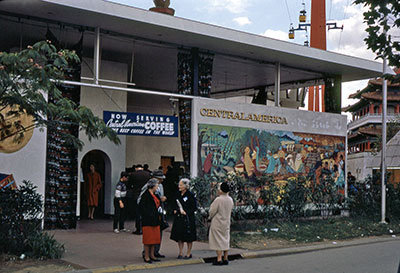
When Panama decided not to return for the 1965 season, the pavilion's name was changed by crudely pulling the lettering off and leaving a very messy scarred wall behind. |
| Century Grill | 
While the guidebook made it sound like the Century Grill would be tough to pass up, most Fairgoers did exactly that. The grill was located just inside the Peter Stuyvesant Gate at the Transportation Area, and it's likely that most visitors raced right past it on their way into the main part of the Fair. 
The Century Grill did not return for the 1965 season, being replaced by the tacky looking "Steak Town USA". |
| Chrysler | 
In 1964 the main building and rocket at Chrysler featured mostly white paint schemes. 
Later in the season several of the panels were painted in brighter colors. 
A view of the Chrysler rocket in 1964. 
The 1965 season saw much more colorful designs. The main building was hard to miss, as seen here in a view from the New York State Pavilion. 
The rocket was also brightly colored for 1965. 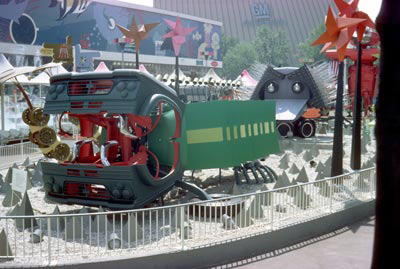
In 1964 the mechanical "Dragonaut" animal was green. 
It was repainted in 1965 to a more visible red. 
In 1964 the pistons inside the Giant Engine were an industrial gray color. 
The interior of the Giant Engine received a brighter paint scheme for the 1965 season. The pavilion also featured an exhibit where visitors could pose for pictures in openings in a giant license plate. A new registration sticker was added to the plate in 1965. |
| Chunky Candy |
Originally a glass tunnel carried newly made candy bars to a wrapping area, but they often melted in the sunlight and an awning was added during the 1964 season to protect them. |
| Churchill Center | 
In 1964 this geodesic dome-topped building was used for a variety of exhibits under the rather generic name of "The World's Fair Pavilion" or just "The Pavilion." 
In 1965 it was used solely for a tribute to Sir Winston Churchill, who had passed away earlier that year. |
| Coca-Cola | 
When the Fair opened there was a blank wall above the pavilion entrance, as seen here just above the Greyhound Escorter. 
By July 3, 1964 a new red and gold mural had been added with depictions of people enjoying soft drinks. Sharp-eyed viewers will note that the curb in front of the building had been painted yellow, probably as the result of people tripping on their way in! 
The entrance fountain was little more than a barren concrete basin in 1964. 
For 1965 a new center fixture was added with surrounding planter boxes. 
Note that one brand of soda was already off the menu in this shot from May 1964. 
There were some changes for 1965 in the vending area, with new drink dispensers and simplified signage. |
| Continental Circus/Continental Park | 
The striped circus tent can be seen in this 1964 view from the New York State Pavilion observation towers, 
A victim of low attendance, the circus did not return for the 1965 season. The space was empty for part of the year and later used for a small collection of children's rides called Continental Park. A small circus tent housed an animal display. |
| Dancing Waters | 
The inflatable Dancing Waters pavilion disappeared sometime in 1965. It can be seen in this view from early that year. 
A later view shows that the pavilion had vanished. |
| Demonstration Center | 
In 1964 this was the Hall of Education building. 
It reopened in 1965 as the Demonstration Center. |
| Dinkelacker Beer Garden | 
When the Fair opened a back corner of the Louisiana Pavilion was set apart as "Teen Carnival". The outer wall featured paintings of teenagers dancing. As the picture shows the area was lacking in ambiance. 
The area was soon converted to a much more interesting use when Dinkelacker took it over to introduce its beers to the US market. |
| Eastern Airlines | 
In 1964 Easter's building featured a red paint scheme. 
Eastern got a new roof and color scheme for the 1965 season as part of the airline's overall re-branding program. |
| Fiesta | 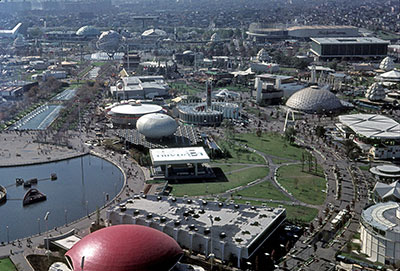
In 1964 a large grassy area was located between the IBM and Festival of Gas pavilions. 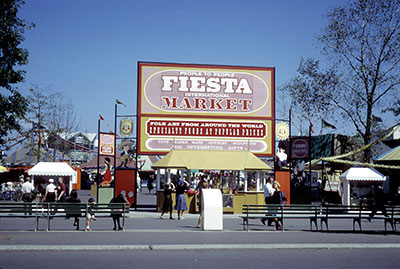
In 1965 this area became the "People to People Fiesta International Market", more commonly known as just Fiesta. |
| Ford | 
The famous glow-in-the-dark badges were given out at this outdoor booth in 1964. It was gone in 1965 and the badges were distributed inside the main pavilion. Other reported changes: Exterior: Interior – Magic Skyway Ride: Interior – Product Salon: |
| General Electric | 
The popular pavilion often had long lines, and in 1964 they were wound through an empty area next door. Confused visitors often didn't know where the line started, and the crowds made it difficult to get through the area. 
In 1965 a covered waiting area was added, helping to reduce some of the crowd control issues while also providing guests a welcome respite from the hot New York sun. |
| General Motors | 
The General Motors pavilion was very popular, leading to long lines right from Opening Day. As large as the building was, it wasn't large enough to accommodate the waiting crowds, leading to long lines in the harsh New York weather. 
A covered waiting area was added sometime after the Fair opened. This second view from the New York State observation towers, taken in late July, 1964, shows the blue and white canopy used to keep guests out of the sunlight. |
| Greece |

When the Fair opened the pavilion had a large colorful mural and a set of windows along the front entrance. 
For 1965 the windows were covered over and the front was mostly white, with a revised mural section off to the right of the entrance. The mural that adorned the front in 1964 was relocated to the rear facing the Philippines in 1965. |
| Greyhound Escorters | 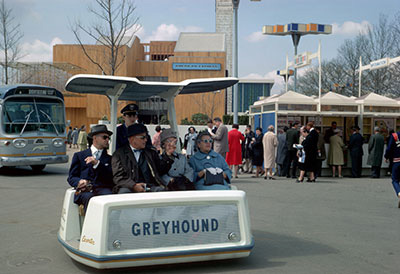
These unique rental vehicles are a great way to date a photo to 1964 as they were only used for the Fair's first season. |
| Greyhound Glide-a-rides | 
In 1964 there were no route signs on top of the tractor units. 
In 1965 some, but not all, tractors had signs designating the route they were taking. If there's a sign on top it's a 1965 view. |
| Hall of Education | 
In 1964 this was the Hall of Education building. 
It reopened in 1965 as the Demonstration Center. |
| Hall of Free Enterprise |
In 1964 the entrance to the building sported the slogan "The Greatest Good for the Greatest Number". This was changed in 1965 to read "The Hall of Free Enterprise". |
| Hall of Science | 
A last-minute addition to the Fair, the Hall of Science was under construction for much of the 1964 season. Some of the exhibits on the lower level opened earlier, but the pavilion wasn't finished and dedicated until September 9, 1964. It's almost done in this August 1964 view. |
| Hong Kong | 
There were three junks outside the building in 1964. 
One was removed for the 1965 season to provide more room for a snack bar. |
| IBM | 
When the Fair first opened the egg-shaped portion of the pavilion was covered in a repeating series of the "IBM" logo in the company's distinctive typeface. To get more attention at night, several sets of the letters were replaced with illuminated letters shortly after opening day. This shot from July 1964 shows work underway to add the new letters. 
The newly added lights can be seen in this view of the pavilion at dusk. |
| Indonesia | 
Unfortunately politics and financing woes led to the early closure of the Indonesia pavilion. Faced with several months of unpaid rent bills, the World's Fair Corporation ordered the pavilion closed in 1965. For the rest of the Fair the building stood empty, with a simple set of barricades blocking the entrance. |
| Japan | 
The exterior walls of the Japan pavilion were relatively free of signage when the Fair opened. 
During the 1964 season signage was added to promote the pavilion's stage show and restaurants. A patio dining area with a striped canopy was also added. 
In 1965 the stage show did not re-open. The word "SHOW" was removed from signs on the side of the building, but it was still visible. The men pictured were operating Tik-Tok, the remote controlled robot. |
| Jaycopter | 
The first Jaycopter, seen here in May 1964, was painted red. 
It was replaced during the 1964 season with a larger yellow model, seen here in September 1964. |
| Kodak |
The giant photos on the Kodak pavilion were changed periodically throughout the two year run of the Fair. Knowing what the dates were for each picture would provide an excellent way of dating a photo, but unfortunately no records have been discovered with such a list and Kodak was unable to supply one. A project for some spare time, perhaps. The "Madcap Theater" area was added in 1965. |
| Les Poupees de Paris | 
When the pavilion opened in 1964 the signage was relatively low key. 
Later in the season new signs were added proclaiming that the new 1965 edition was already there. 
In 1965 the statues on the roof were removed and new signage added in several languages proclaiming that the show was a "smash hit". |
| Lithuanian Wayside Cross | 
This replica of a roadside shrine was added for 1965 near the Garden of Meditation. |
| Löwenbräu | 
When the Fair first opened the area was billed as "Löwenbräu Munich". 
The area was re-named to "Löwenbräu Gardens" during the first season of the Fair. This included the signage on the beer wagon that traveled around the Fair site. 
The bandstand was open to the sky in 1964. 
A canopy was added for the 1965 season. |
| Meadow Lake Bridge | 
This view dated July 1964 shows an unbroken walkway on the right side of the Meadow Lake Bridge. 
A slide dated September 1964 shows a newly constructed wooden staircase. 
By 1965 there was also a ramp opposite the stairs. It appears the stairs and ramps were added to make it easier for those passing by to detour for a visit to the nearby Bourbon Street. |
| Mexico | 
In 1964 a replica of an ancient Aztec calendar could be found on the pavilion's patio. 
In 1965 the calendar was replaced by a 16-ton stone Olmec head. The purpose of these giant heads is unknown. |
| Minnesota | 
A statue of "Big Ole", a giant-sized Viking warrior, was added for 1965, along with a Viking ship. Additional Viking displays were also added inside the pavilion. 
Unfortunately Big Ole's massive sword proved to be too tempting a target for some rowdy visitors and was broken off midway through the season. |
| New England | 
A press release described one of the changes for 1965: A 150-foot ski slope, towering 60 feet in the air, will be located beside the Regional Theme Building. Live skiing demonstrations will be given several times daily. |
| New Jersey | 
In 1964 there was no signage on the New Jersey Pavilion visible from the New York State Pavilion. 
In 1965 a bright yellow stripe was added to a roof facing the New York State Pavilion observation towers with the message: 
Another change took place between seasons. In 1964 the main entrance to the pavilion featured copies of the state seal on either side of the name, with several small photos in the center section. 
Only one large state seal was there in 1965, and the photos were gone. |
| New York City Building | 
When the Fair first opened the New York City Building featured two major exhibits, which were both prominently featured on signage on the building side that faced the Unisphere. The giant panorama model of the city lasted both seasons, but you had to look fast to see the other one, "Dick Button's Ice-Travagaza". 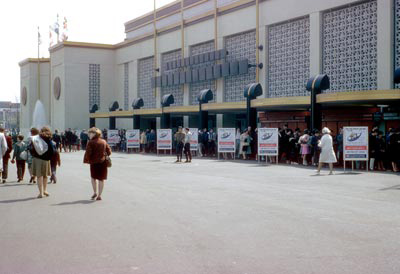
he ice show was one of the first to close, due to low attendance, and the sign was covered over for the remainder of the 1964 season. 
In 1965 the sign was revised to list the panorama, much like the one on the other side of the wall that was first seen in 1964. The two signs weren't identical, though, as the different number of letters originally in the sign for the ice show meant that the letters had to be spaced out slightly differently. |
| Oklahoma | 
One of the kiosks became a Chicken Delight restaurant for the 1965 season. |
| Pan American Highway Gardens | 
The Pan American Highway Gardens were a tranquil but generally ignored spot in 1964.  Go-Kart track for 1965 Go-Kart track for 1965
The area was much busier - and far more noisy - with the arrival of a Avis go-cart track in 1965. |
| Paris | 
When the pavilion first opened the designers somehow had neglected to have any signage listing its name. Perhaps this was due to it initially being planned as the "France" pavilion. 
The pavilion's name was added shortly after opening day. 
The wooden sculpture located at the entrance in 1964 was replaced by a group of flagpoles flying the French flag for 1965, along with larger signage. |
| Pavilion of Fine Art | 
Originally planned as the Argentina Pavilion, the building was turned into the Pavilion of Fine Art after the original developers ran out of money and were unable to complete construction. 
In 1965 the building became the Bargreen Buffet, a restaurant complex. |
| Pennsylvania | 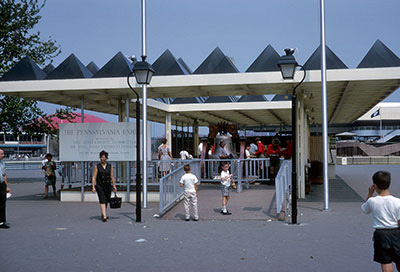
This exhibit was added for the 1965 season. |
| Pepsi | 
Snow White and the Seven Dwarfs were part of the Disney characters seen at or near the Pepsi Pavilion in 1964. 
They were replaced for the 1965 season by Chip and Dale. |
| Polynesia | 
In 1964 the Polynesia Restaurant had small covers near the stage areas to block some of the sunlight. 
More substantial shade covers were added for 1965. |
| Port Authority | 
When the Fair opened there was a Sikorsky helicopter on display at the base of the pavilion painted in a generic scheme supplied by the manufacturer. 
Not long after opening it was replaced by one painted in a new scheme used for the fleet of sightseeing helicopters. 
The 1965 season featured a vintage Ford Tri-Motor airplane as part of an American Airlines exhibit. When the Fair first re-opened for the season the plane was surrounded by a small chain, and was in front of a blank wall. 
By June the chain had been replaced by a more formidable fence, and the wall sported aviation artwork. |
| Protestant and Orthodox Center | 
When the pavilion opened there was no signage explaining what the cross signified. 
Shortly after opening new signage was added. This initial signage used ornate silver lettering which was difficult to see against the concrete background. 
By September 1964 the lettering was changed to a simpler gold style. The lettering was a problem throughout both seasons. Pictures often show letters were missing, either from falling off or being pried off by vandals and/or souvenir hunters. |
| Quaker Puffed Cereals House | 
The "house" was actually just a giant box featuring Quaker cereals. The main attraction were aerialists who were shot out of a giant cannon. The Quaker exhibit was added to the Lake Amusement Area on June 28, 1965. |
| RCA | 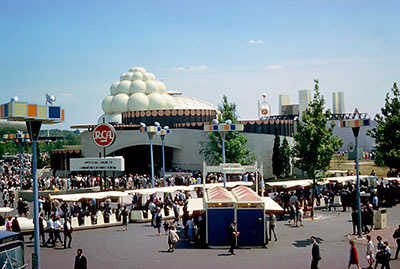
When the Fair first opened the sign outside RCA proclaimed it to be the OFFICIAL COLOR TV 
By August 1964 the sign had been changed to read COLOR TELEVISION 
The words "COLOR" were changed by September 1964 to use colored letters instead of the original all-back ones. |
| Santa Maria | 
In 1964 the ship was not clearly identified except at the entrance building. 
In 1965 the ship's name was added at the entrance gate and the ship's stern, starboard side, and crow's nest. 
The entrance building as seen in 1964. 
In 1965, a small restaurant under a tent was added at the admission gate in an area that was a gravel path for the first season. |
| Sierra Leone | 
In 1964 this tent-shaped building was the Sierra Leone pavilion. 
Economic woes led to the closure of this pavilion at the end of the 1964 season. The building became the United Nations pavilion in 1965 and received a new paint job. |
| Simmons | 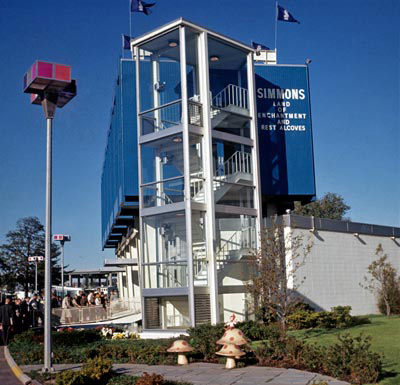
In 1964 the pavilion listed "Land of Enchantment and Rest Alcoves" on its signage. 
In 1965 the Land of Enchantment was gone. |
| Sinclair | 
This display of baby brontosauruses was added for the 1965 season. Sadly the baby brontosaurus had the head broken off during the year but it was repaired. The motorized bird flying over the eggs disappeared sometime during the season. It was replaced later when the dinosaurs were displayed on a road tour of shopping malls. |
| Steaktown USA | 
While the guidebook made it sound like the Century Grill would be tough to pass up, most Fairgoers did exactly that. The grill was located just inside the Peter Stuyvesant Gate at the Transportation Area, and it's likely that most visitors raced right past it on their way into the main part of the Fair. 
The Century Grill did not return for the 1965 season, being replaced by the tacky looking "Steak Town USA". |
| Swiss Sky Ride | 
In 1964 the support pylons were white. 
The pylon faces were painted red in 1965, with the sides left white. |
| Teen Carnival | 
When the Fair opened a back corner of the Louisiana Pavilion was set apart as "Teen Carnival". The outer wall featured paintings of teenagers dancing. As the picture shows the area was lacking in ambiance. 
The area was soon converted to a much more interesting use when Dinkelacker took it over to introduce its beers to the US market. |
| Texas Pavilions | 
The Texas Pavilions featured the Music Hall and its show "To Broadway With Love." While critically acclaimed, the show was a box office failure and closed during the 1964 season. 
In 1965 there was a new attraction, Carnival, which featured a disco and small amusement rides. |
| Tower of Light | 
When the pavilion first opened the name of the show inside, "The Brightest Show on Earth," was included on the signage at the pavilion entrance. 
"The Brightest Show on Earth" sign was gone by June 1964. The pavilion had a new show for 1965, "Holiday With Light." |
| Tower of the Four Winds | 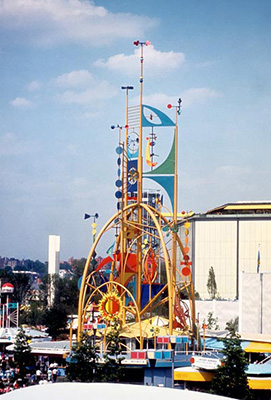
Disney's fanciful tower outside the Pepsi-Cola Pavilion featured a yellow frame in 1964. 
It was repainted white for 1965. |
| Transportation & Travel | 
In 1964 Allied Van Lines had a display behind the main building featuring a large orange moving van, and the U.S. Army showed off a movable scissor bridge. 
In 1965 they were replaced by an exhibit on the U.S. Navy's Polaris missile and a Nashua mobile home display. |
| Travelers Insurance | 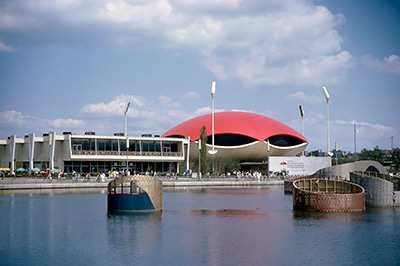
In 1964 the roof was painted a solid red. 
A "T" in a white circle was added for 1965. |
| United Nations | 
In 1964 this tent-shaped building was the Sierra Leone pavilion. 
Economic woes led to the closure of this pavilion at the end of the 1964 season. The building became the United Nations pavilion in 1965 and received a new paint job. |
| United States | 
The sign at the entrance to the pavilion went through numerous changes during the Fair. At first it sported just the pavilion's name and a raised eagle. 
At some point in early 1964 the name and title of "Norman K. Winston, Commissioner" was added, centered under the eagle. 
This new signage didn't last long and was crudely covered over. 
The next change saw the "Norman K. Winston, Commissioner" wording moved to the lower right 
The previous paint job under the eagle was then redone more professionally. 
All of those visitors posing for pictures took a toll on the lights at the base of the sign, resulting in misalignment or complete destruction. 
During 1965 a small guardrail was then added to protect the lights, with additional security provided by the Boy Scouts. 
1965 also saw the introduction of a new display, "The Hall of Presidents." It featured memorabilia from the nation's chief executives, not robotic figures like the later show at Walt Disney World. |
| United States Space Park | 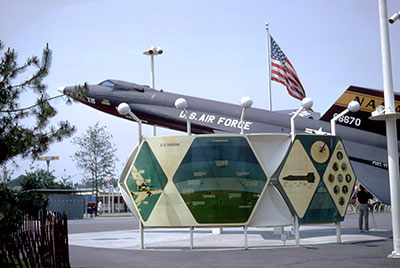
In 1964 the X-15 mock-up was an X-15-1, tail number 66670. 
In 1965 it was updated to represent the re-built version of the second X-15 aircraft, the X-15A-2, tail number 66671. New external propellant tanks were added to it as well. |
| Unknown snack bar | 
A small snack bar was added for 1965 to a vacant slice of land between the Guinea and Sermons from Science pavilions. |
| Unknown souvenir stands | A small souvenir stand was added in 1965 at the intersection of the Avenue of Commerce and the Court of the Sun, just behind the Industrial Common and the Tiparillo Bandstand. It can be seen just above the oval-shaped Family Phone Booth. 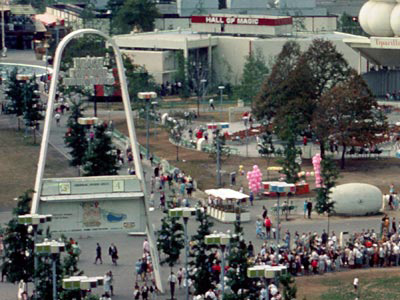
1964 
1965 Another souvenir stand was also added to the area for 1965. It can be seen at the bottom of the 1965 view of the General Electric waiting area, located earlier on this page. It evidently sold film as well as other items. 
1964 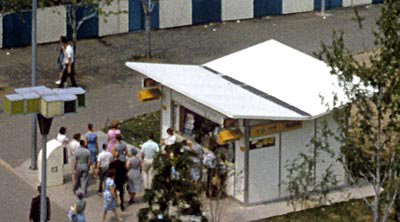
1965 |
| U.S. Royal Giant Tire | 
When the Fair first opened the hub caps on the Giant Tire read "US Rubber". 
The hub caps were changed in late July or early August 1964 to reflect the parent company, UniRoyal, as part of a company-wide re-branding. |
| Vatican Pavilion | 
In 1964 the altar faced the rear wall of the chapel. 
Following reforms enacted worldwide that year, the altar was moved forward and modified so the officiating priest would now be facing the congregation. Seating for those performing the ceremony was added at the rear wall, and a painting was added. 
During the 1965 season the newly added painting was later replaced by a small sculpture. 
The Father Mendel Garden of Heredity was added for 1965. The area used was a grass lawn in 1964. The garden was formally dedicated on June 20, 1965. |
| Venezuela | 
In 1964 the entrance area featured a small plaza and garden. 
In 1965 a statue of Simon Bolivar was added. This is how it looked on July 2, 1965. 
Actually, there were two different statues of Simon Bolivar! The one seen on July 2 was replaced later that month with a different one. It was on the same pedestal, but the actual bust itself is completely different. |
| WBT 2,000 Tribes | 
In 1964 the totem poles at the side of the building were partially blocked off by plants. 
The area around the totem poles became a photo opportunity site in 1965, with a larger concrete pad, signage for the pavilion, and a short walkway from the street. Incidentally, there were three totem poles each year; many shots seem to only show two due to the camera angle. |
| West Virginia | 
The West Virginia pavilion featured a pleasant patio looking at one end during the 1964 season. 
The area was rebuilt for the 1965 season as a rather unattractive indoor dining area. The addition didn't match the rest of the pavilion design at all. A new sign with the pavilion's name was added as well. |
| World's Fair Pavilion | 
In 1964 this geodesic dome-topped building was used for a variety of exhibits under the rather generic name of "The World's Fair Pavilion" or just "The Pavilion." 
In 1965 it was used solely for a tribute to Sir Winston Churchill, who had passed away earlier that year. |
